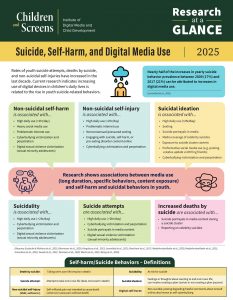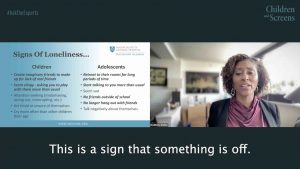 Youth self-harm and suicide rates have risen over the past decade–and digital media may be playing a role. Understanding the connection between screen time, the ways youth use digital media, and youth mental health is more important than ever.
Youth self-harm and suicide rates have risen over the past decade–and digital media may be playing a role. Understanding the connection between screen time, the ways youth use digital media, and youth mental health is more important than ever.
Children and Screens’ newest Research-at-a-Glance on “Suicide, Self-Harm, and Digital Media Use” distills the latest research into a clear, two-page visual summary designed especially for parents, caregivers, and professionals who work with children and adolescents.
Beauroy-Eustache, O.D., & Mishara, B.L. (2021). Systematic review of risk and protective factors for suicidal and self-harm behaviors among children and adolescents involved with cyberbullying. Preventive Medicine, 152. https://doi.org/10.1016/j.ypmed.2021.106684
Biernesser, C., Sewall, C., Brent, D., Bear, T., Mair, C., & Trauth, J. (2020). Social media use and deliberate self-harm among youth: A systematized narrative review. Child and Youth Services Review, 116. doi: 10.1016/j.childyouth.2020.105054
Boyd, S.I., Moore, A., Moghaddas, S., & Hamilton, J.L. (2024). Perceived functions and importance of digital media use and adolescent depression and suicidal ideation. Journal of Adolescence, 96(5), 1001–1011. https://doi.org/10.1002/jad.12311
Burke, T.A., Bettis, A.H., Walsh, R.F., Levin, R.Y., Lawrence, H.R., Sheehan, A.E.,…& Liu, R.T. (2023). Nonsuicidal self-injury in preadolescents. Pediatrics, 152(6). https://doi.org/10.1542/peds.2023-063918
Dickter, B., Bunge, E.L., Brown, L.M., Leykin, Y., Soares, E.E., Van Voorhees, B.,…& Gladstone, T.R.G. (2019). Impact of an online depression prevention intervention on suicide risk factors for adolescents and young adults. mHealth, 5. https://doi.org/10.21037/mhealth.2019.04.01
Durkee, T., Hadlaczky, G., Westerlund, M., & Carli, V. (2011). Internet pathways in suicidality: A review of the evidence. International Journal of Environmental Research and Public Health, 8(10), 3938-3952. doi: 10.3390/ijerph8103938
Gansner, M., Berson, C., & Javed, Z. (2024). Social media contagion of high-risk behaviors in youth. Pediatric Clinics of North America, 42(2), 337-346. https://doi.org/10.1016/j.pcl.2024.07.037
Hamilton, J.L., Dalack, M., Boyd, S.I., Jorgensen, S., Dreier, M.J., Sarna, J., & Brent, D.A. (2024). Positive and negative social media experiences and proximal risk for suicidal ideation in adolescents. Journal of Child Psychology and Psychiatry, 65, 1580-1589. https://doi.org/10.1111/jcpp.13996
Kingsbury, M., Reme, B.A., Skogen, J.C., Sivertsen, B., Øverland, S., Cantor, N.,…& Colman, I. (2021). Differential associations between types of social media use and university students’ non-suicidal self-injury and suicidal behavior. Computers in Human Behavior, 115. https://doi.org/10.1016/j.chb.2020.106614
Leventhal, A.M., Cho, J., Keyes, K.M., Zink, J., Riehm, K.E., Zhang, Y., & Ketema, E. (2021). Digital media use and suicidal behavior in U.S. adolescents, 2009–2017. Preventive Medicine Reports, 23, 101497. https://doi.org/10.1016/j.pmedr.2021.101497
Marchant, A., Hawton, K., Stewart, A., Montgomery, P., Singaravelu, V., Lloyd, K.,…& John, A. (2017). A systematic review of the relationship between internet use, self-harm and suicidal behaviour in young people: The good, the bad and the unknown. PloS One, 12(8), e0181722. https://doi.org/10.1371/journal.pone.0193937
Meldrum, R.C., Patchin, J.W., Young, J., & Hinduja, S. (2020). Bullying victimization, negative emotions, and digital self-harm: Testing a theoretical model of indirect effects. Deviant Behavior, 43(3), 303-321. https://doi.org/10.1080/01639625.2020.1833380
Niederkrotenthaler, T., Braun, M., Pirkis, J., Stack, S., Sinyor, M., Tran, U.S.,…& Spittal, M.J. (2020). Association between suicide reporting in the media and suicide: Systematic review and meta-analysis. BMJ, 368. doi: 10.1136/bmj.m575
Niederkrotenthaler, T., Kirchner, S., Pirkis, J., Till, B., Sinyor, M., Tran, U.S.,…& Spittal, M.J. (2021). Systematic review and meta-analyses of suicidal outcomes following fictional portrayals of suicide and suicide attempt in entertainment media. EClinicalMedicine, 36. https://doi.org/10.1016/j.eclinm.2021.100922
Patchin, J.W., Hinduja, S., & Meldrum, R.C. (2023). Digital self‐harm and suicidality among adolescents. Child and Adolescent Mental Health, 28(1), 52-59. https://doi.org/10.1111/camh.12574
Patchin, J.W., & Hinduja, S. (2024). Adolescent digital self-harm over time: Prevalence and perspectives. Journal of School Violence, 23, 542-554. https://doi.org/10.1080/15388220.2024.2349566
Perini, I., Gustafsson, P.A., Hamilton, J.P., Kämpe, R., Mayo, L.M., Heilig, M., & Zetterqvist, M. (2019). Brain-based classification of negative social bias in adolescents with non-suicidal self-injury: Findings from stimulated online social interaction. EClinicalMedicine, 13, 81-90. https://doi.org/10.1016/j.eclinm.2019.06.016
Robinson, J., Hill, N.T.M., Thorn, P., Battersby, R., Teh, Z., Reavley, N.J.,…& Skehan, J. (2018). The #chatsafe project. Developing guidelines to help young people communicate safely about suicide on social media: A Delphi study. PLOS ONE, 13(11), e0206584. https://doi.org/10.1371/journal.pone.0206584
Stallard, P., Whittle, K., Moore, E., Medina-Lara, A., Morrish, N., Cliffe, B.,…& Taylor, G. (2024). Clinical effectiveness and safety of adding a self-harm prevention app (BlueIce) to specialist mental health care for adolescents who repeatedly self-harm: A single blind randomised controlled trial (the BASH study). Psychiatry Research, 339, 116017. https://doi.org/10.1016/j.psychres.2024.116017
Srivastava, A., Rusow, J., Schrager, S.M., Stephenson, R., & Goldbach, J.T. (2022). Digital sexual violence and suicide risk in a national sample of sexual minority adolescents. Journal of Interpersonal Violence, 38, 4443–4458. doi: 10.1177/08862605221116317
Swedo, E.A., Beauregard, J.L., de Fijter, S., Werhan, L., Norris, K., Montgomery, M.P.,…& Sumner, S.A. (2021). Associations between social media and suicidal behaviors during a youth suicide cluster in Ohio. J Adolesc Health, 68(2), 308-316. doi: 10.1016/j.jadohealth.2020.05.049
Tørmoen, A.J., Myhre, M., Walby, F.A., Grøholt, B., & Rossow, I. (2020). Change in prevalence of self-harm from 2002 to 2018 among Norwegian adolescents. European Journal of Public Health, 30(4), 688-692. https://doi.org/10.1093/eurpub/ckaa042
Tynes, B.M., Maxie-Moreman, A., Hoang, T.M., Willis, H.A., & English, D. (2024). Online racial discrimination, suicidal ideation, and traumatic stress in a national sample of black adolescents. JAMA Psychiatry, 81(3), 312-316. doi:10.1001/jamapsychiatry.2023.4961
Wachs, S., Wright, M.F., Gámez-Guadix, M., & Döring, N. (2021). How are consensual, non-consensual, and pressured sexting linked to depression and self-harm? The moderating effects of demographic variables. International Journal of Environmental Research and Public Health, 18(5). https://doi.org/10.3390/ijerph18052597
Wang, L., Liu, X., Liu, Z.Z., & Jia, C.X. (2020). Digital media use and subsequent self-harm during 1-year follow-up of Chinese adolescents. Journal of Affective Disorders, 277, 279-286. https://doi.org/10.1016/j.jad.2020.05.066




